Seagate Technology Bundle
How Did Seagate Technology Shape the Digital World?
Imagine a world before terabytes, where storing data was a cumbersome and expensive endeavor. Seagate Technology, a Seagate Technology SWOT Analysis, emerged in 1979 with a revolutionary vision: to shrink and democratize data storage. This hard drive manufacturer changed the course of computing forever, its early innovations paving the way for the digital age we know today. From its humble beginnings, Seagate company has become a global leader.
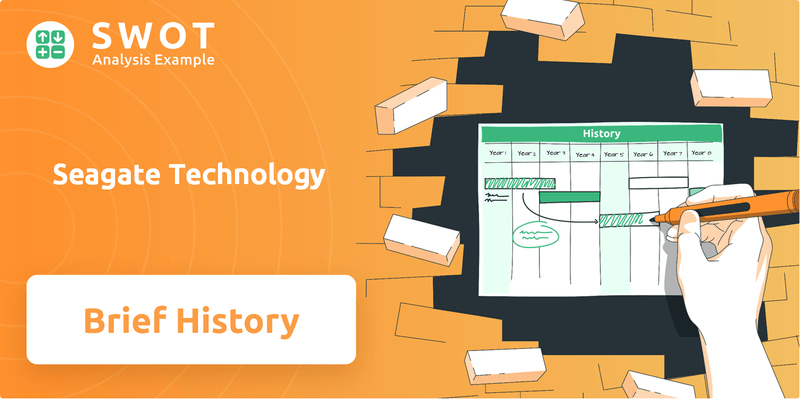
This Seagate history unveils the fascinating story of a company that not only survived but thrived in the cutthroat world of data storage. Explore Seagate's evolution in data storage, from its pioneering disk drive technology to its current position as a titan in the industry. Discover the Seagate's key milestones and understand how Seagate Technology continues to shape our digital future, including its Seagate's acquisition history and Seagate's product development.
What is the Seagate Technology Founding Story?
The story of Seagate Technology began on November 1, 1979. It was founded by a team of industry veterans. They saw an opportunity in the growing personal computer market.
The founders were Al Shugart, Finis Conner, Tom Mitchell, Doug Mahon, and Scott Gibson. Al Shugart brought experience from the floppy disk drive industry. They focused on making smaller, more affordable hard disk drives.
Their goal was to make data storage more accessible. Their first product, the ST-506, was a 5.25-inch hard disk drive. It had a capacity of 5 megabytes. This innovation set a new standard in the industry.
Seagate's early success was driven by its innovative approach to data storage.
- Founding Date: November 1, 1979.
- Founders: Al Shugart, Finis Conner, Tom Mitchell, Doug Mahon, and Scott Gibson.
- Initial Product: ST-506, a 5.25-inch hard disk drive with 5MB capacity.
- Market Focus: Personal computer market, addressing the need for compact and affordable storage.
Initially, the company was named Shugart Technology. However, a trademark dispute led to a quick rebranding to Seagate Technology. Venture capital provided the initial funding. The team's expertise in magnetic recording and drive design was key to their success.
Seagate Technology SWOT Analysis
- Complete SWOT Breakdown
- Fully Customizable
- Editable in Excel & Word
- Professional Formatting
- Investor-Ready Format
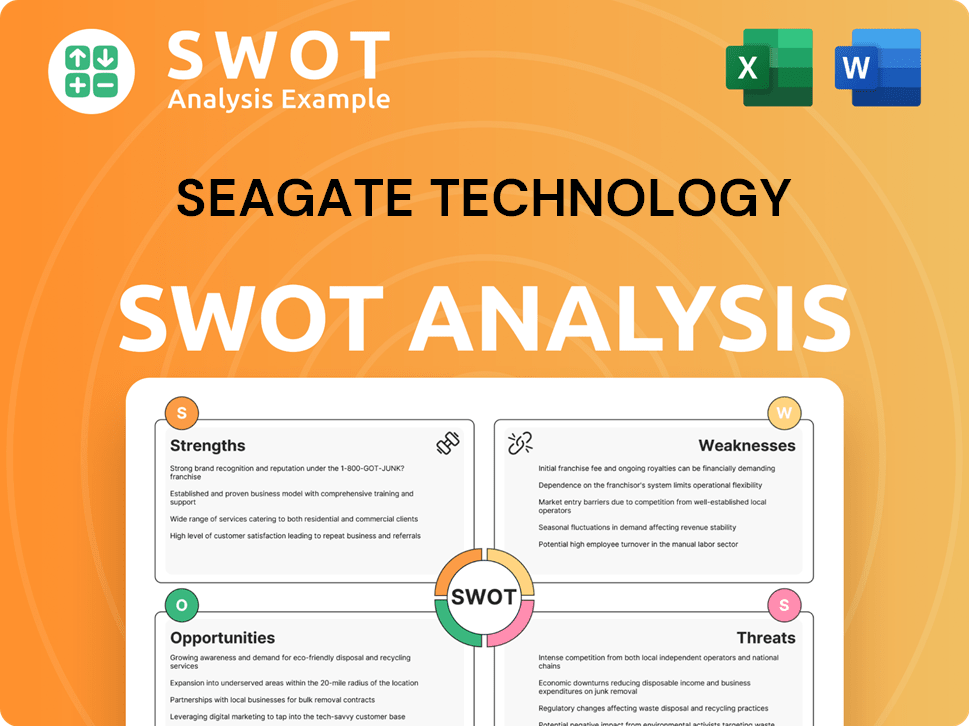
What Drove the Early Growth of Seagate Technology?
The early growth of Seagate Technology was remarkable, driven by the burgeoning personal computer market and the success of its ST-506 drive. The Seagate company quickly expanded its manufacturing capabilities to meet the soaring demand for data storage solutions. In 1982, the company shipped over 100,000 units of the ST-506, establishing itself as a leader in the hard drive market.
Seagate Technology went public in 1981, which provided the capital needed for further expansion and product development. Early product releases included higher-capacity versions of the 5.25-inch form factor and diversification into different drive interfaces. This strategic move allowed Seagate to maintain its competitive edge in the rapidly evolving data storage industry.
A significant milestone in Seagate's early expansion was the establishment of manufacturing facilities in Asia, particularly in Singapore. This strategic move allowed Seagate to leverage cost efficiencies and scale production to unprecedented levels. This was crucial for the hard drive manufacturer to stay competitive.
Throughout the 1980s, Seagate broadened its product portfolio, introducing drives with increased storage capacities and improved performance. The company also began to explore new market segments beyond personal computers, including workstations and early server applications. The demand for digital storage continued its exponential growth, which fueled Seagate's success. Read more about the Marketing Strategy of Seagate Technology.
Key leadership transitions occurred as the Seagate company matured, with continuous investment in research and development to stay ahead in a rapidly evolving technological landscape. Despite increasing competition, the market reception for Seagate's products remained strong. The company's early years were marked by significant innovation and strategic decisions that shaped its future in the data storage industry.
Seagate Technology PESTLE Analysis
- Covers All 6 PESTLE Categories
- No Research Needed – Save Hours of Work
- Built by Experts, Trusted by Consultants
- Instant Download, Ready to Use
- 100% Editable, Fully Customizable
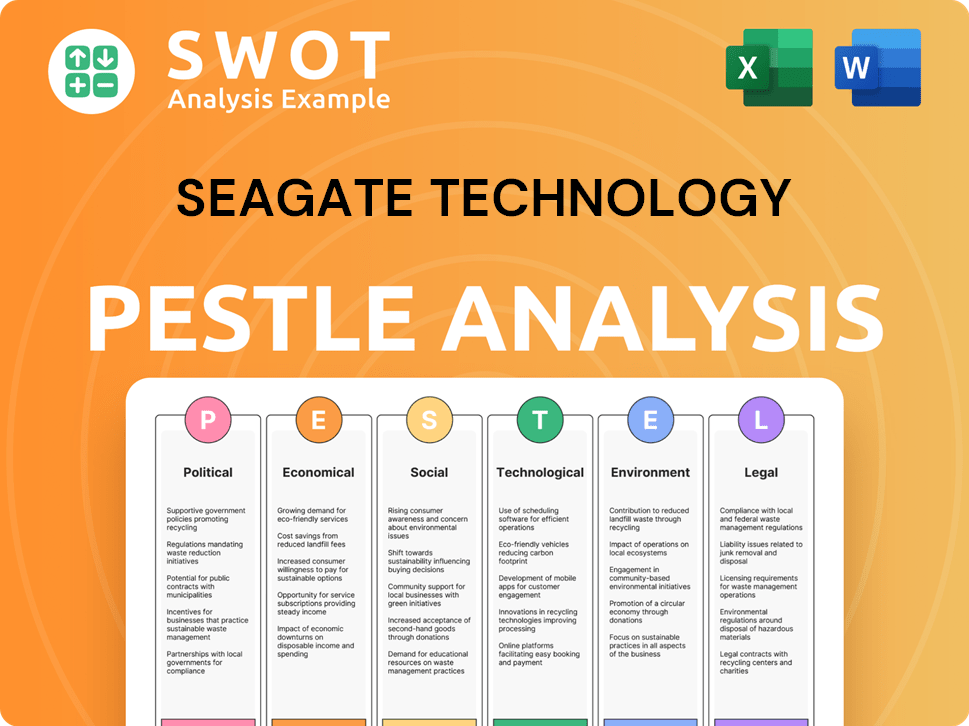
What are the key Milestones in Seagate Technology history?
The brief history of Seagate Technology is marked by significant milestones that have shaped the data storage industry. From its early days to its current position as a leading hard drive manufacturer, the company has consistently pushed the boundaries of what's possible in data storage. The Seagate Technology company timeline showcases its adaptability and innovation in a rapidly evolving market.
| Year | Milestone |
|---|---|
| 1979 | Founded as Shugart Technology, later renamed Seagate Technology. |
| 1980 | Introduced the ST-506, the first 5.25-inch hard disk drive for personal computers. |
| 1990s | Launched the Barracuda family of drives, among the first with high rotational speeds. |
| 2006 | Acquired Maxtor Corporation, consolidating its position in the hard drive market. |
| 2011 | Acquired Samsung's hard disk drive business, expanding its market share. |
| 2023 | Shipped 136 exabytes of nearline storage, demonstrating its continued leadership in mass capacity storage. |
Seagate Technology has consistently been at the forefront of innovation in data storage. The company pioneered perpendicular magnetic recording (PMR) technology, significantly increasing storage density. More recently, Seagate is developing Heat-Assisted Magnetic Recording (HAMR) technology to push hard drive capacities to new heights.
PMR technology enabled the development of multi-terabyte hard drives, revolutionizing data storage capabilities.
The Barracuda family of drives offered high rotational speeds, significantly improving data access times and performance.
HAMR technology promises to significantly increase hard drive capacities, pushing the boundaries of data storage.
Seagate has consistently focused on developing high-capacity drives to meet the growing demands of data centers and cloud storage.
The company has expanded its focus on enterprise storage solutions to cater to the needs of businesses and data centers.
Seagate has diversified its product portfolio to include SSDs and hybrid drives to stay competitive in the market.
Despite its successes, Seagate has faced several challenges throughout its history. The rise of solid-state drives (SSDs) presented a significant competitive threat, prompting diversification. Economic downturns and natural disasters, such as the 2011 Thailand floods, also impacted the Seagate hard drive history.
The data storage industry is characterized by intense price competition, affecting profitability.
The rise of SSDs has presented a significant challenge, requiring Seagate to adapt its product offerings.
Economic fluctuations have impacted demand and sales in the data storage market.
Events like the 2011 Thailand floods severely impacted hard drive production and supply chains.
Changes in computing, such as the growth of cloud computing, have required Seagate to adapt its strategies.
The data storage market is subject to cyclical demand and rapid technological advancements.
To learn more about the company's core values and mission, you can read this article about Seagate's mission, vision, and core values.
Seagate Technology Business Model Canvas
- Complete 9-Block Business Model Canvas
- Effortlessly Communicate Your Business Strategy
- Investor-Ready BMC Format
- 100% Editable and Customizable
- Clear and Structured Layout
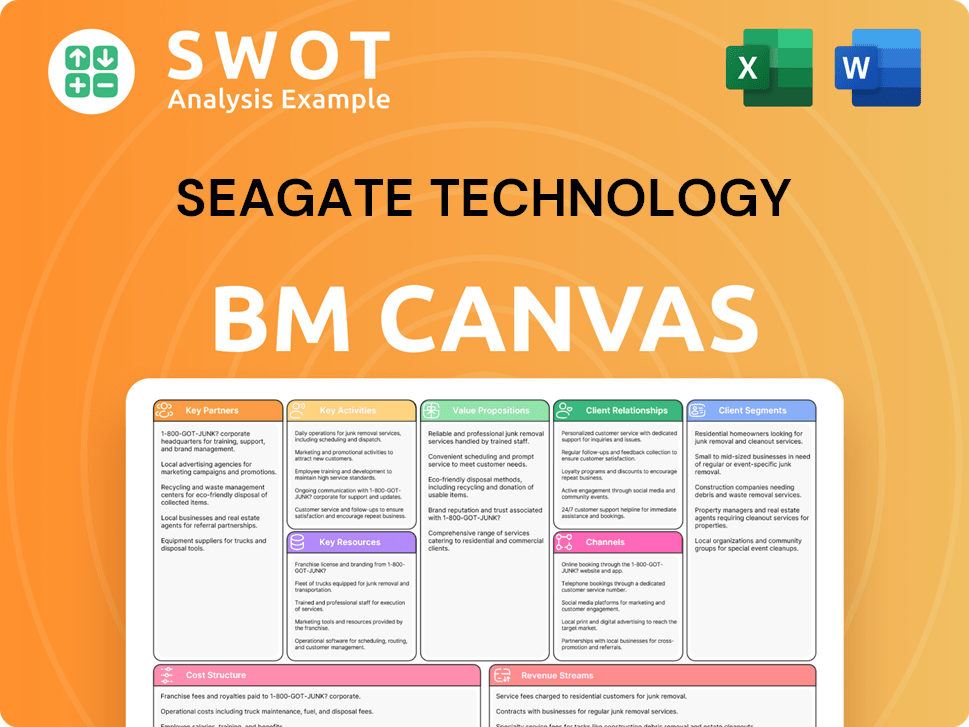
What is the Timeline of Key Events for Seagate Technology?
The Seagate Technology journey is marked by significant milestones in the data storage industry. This hard drive manufacturer has consistently pushed the boundaries of data storage and disk drive technology since its inception.
| Year | Key Event |
|---|---|
| 1979 | Seagate Technology is founded, marking the beginning of its journey in the storage industry. |
| 1980 | Introduces the ST-506, the first 5.25-inch hard disk drive, revolutionizing data storage. |
| 1981 | The company goes public, a significant step in its growth and expansion. |
| 1992 | Introduces the Barracuda drive, one of the first 7,200 RPM hard drives, enhancing performance. |
| 2000 | Ships its 250 millionth hard drive, a testament to its market presence. |
| 2006 | Acquires Maxtor Corporation, expanding its market share and capabilities. |
| 2011 | Acquires Samsung's hard disk drive business, consolidating its position in the market. |
| 2014 | Ships its two billionth hard drive, highlighting its massive production scale. |
| 2017 | Introduces the Exos X16, a 16TB helium-filled hard drive, setting new capacity standards. |
| 2020 | Begins shipping HAMR-based drives for qualification, showcasing its technological innovation. |
| 2023 | Announces 30TB+ HAMR drives are shipping for qualification, pushing storage limits further. |
| 2024 | Continues to advance HAMR technology for higher capacities, focusing on future storage needs. |
| 2025 | Expected continued focus on mass capacity storage and energy efficiency, shaping its future. |
The company is strategically focused on mass capacity storage solutions, especially for cloud and enterprise data centers. This is driven by the increasing demand for storing massive datasets. The market for mass capacity storage is projected to grow significantly in the coming years.
Heat-Assisted Magnetic Recording (HAMR) technology is a key area of investment. HAMR is crucial for achieving hard drive capacities of 50TB and beyond. The continued development of HAMR is essential for maintaining a competitive edge in the storage market.
The company is optimizing its product portfolio to meet the growing demands of AI and machine learning workloads. These applications require significant storage infrastructure. This strategic alignment is expected to drive future growth and market share.
Sustainability is a key focus, with an emphasis on energy-efficient storage solutions. This includes reducing power consumption and promoting environmentally friendly manufacturing processes. These efforts align with global trends toward sustainable technology.
Seagate Technology Porter's Five Forces Analysis
- Covers All 5 Competitive Forces in Detail
- Structured for Consultants, Students, and Founders
- 100% Editable in Microsoft Word & Excel
- Instant Digital Download – Use Immediately
- Compatible with Mac & PC – Fully Unlocked
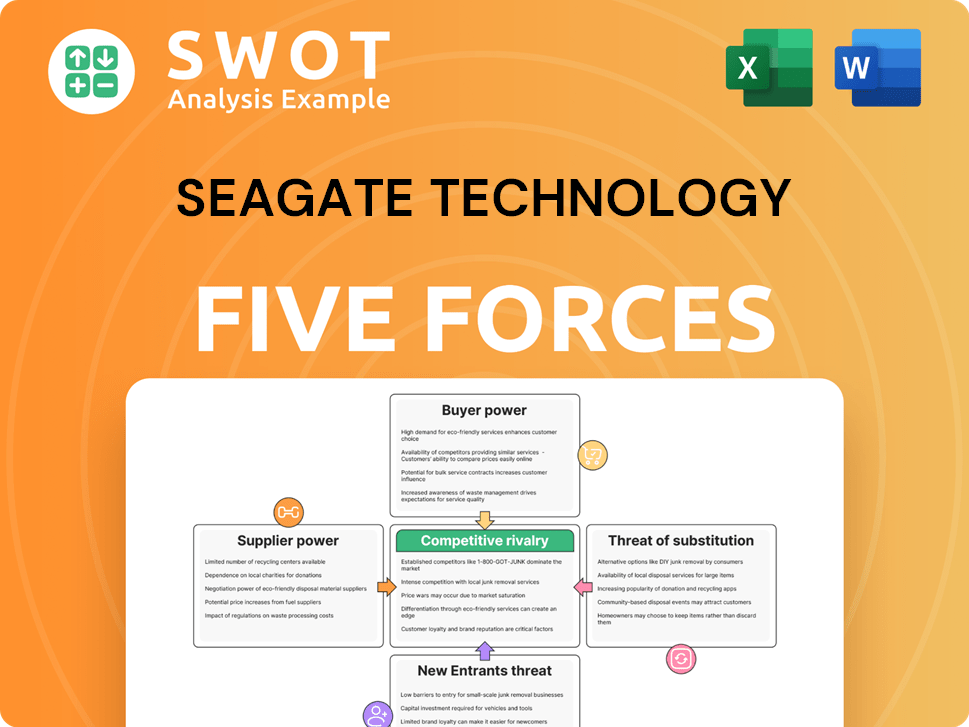
Related Blogs
- What is Competitive Landscape of Seagate Technology Company?
- What is Growth Strategy and Future Prospects of Seagate Technology Company?
- How Does Seagate Technology Company Work?
- What is Sales and Marketing Strategy of Seagate Technology Company?
- What is Brief History of Seagate Technology Company?
- Who Owns Seagate Technology Company?
- What is Customer Demographics and Target Market of Seagate Technology Company?
Disclaimer
All information, articles, and product details provided on this website are for general informational and educational purposes only. We do not claim any ownership over, nor do we intend to infringe upon, any trademarks, copyrights, logos, brand names, or other intellectual property mentioned or depicted on this site. Such intellectual property remains the property of its respective owners, and any references here are made solely for identification or informational purposes, without implying any affiliation, endorsement, or partnership.
We make no representations or warranties, express or implied, regarding the accuracy, completeness, or suitability of any content or products presented. Nothing on this website should be construed as legal, tax, investment, financial, medical, or other professional advice. In addition, no part of this site—including articles or product references—constitutes a solicitation, recommendation, endorsement, advertisement, or offer to buy or sell any securities, franchises, or other financial instruments, particularly in jurisdictions where such activity would be unlawful.
All content is of a general nature and may not address the specific circumstances of any individual or entity. It is not a substitute for professional advice or services. Any actions you take based on the information provided here are strictly at your own risk. You accept full responsibility for any decisions or outcomes arising from your use of this website and agree to release us from any liability in connection with your use of, or reliance upon, the content or products found herein.